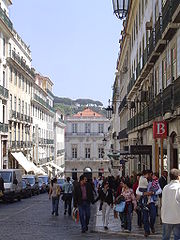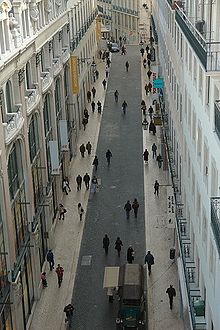
Chiado
Encyclopedia

Lisbon
Lisbon is the capital city and largest city of Portugal with a population of 545,245 within its administrative limits on a land area of . The urban area of Lisbon extends beyond the administrative city limits with a population of 3 million on an area of , making it the 9th most populous urban...
, in Portugal
Portugal
Portugal , officially the Portuguese Republic is a country situated in southwestern Europe on the Iberian Peninsula. Portugal is the westernmost country of Europe, and is bordered by the Atlantic Ocean to the West and South and by Spain to the North and East. The Atlantic archipelagos of the...
. The Chiado is located between the neighbourhoods of Bairro Alto
Bairro Alto
Bairro Alto is an area of central Lisbon, Portugal.The first terrain division occurred around 1500, when the court of D.Manuel I moved from the castle to the royal palace in Terreiro do Paço...
and Baixa Pombalina.
The Chiado is a traditional shopping area that mixes old and modern commercial establishments, concentrated specially in the Carmo and Garrett Streets. Locals as well as tourists visit the Chiado to buy books, garments, pottery as well as to have a cup of coffee. The most famous café of Chiado is "A Brasileira
A Brasileira
The Café A Brasileira is one of the oldest and most famous cafés in the old quarter of Lisbon, in the civil parish of Sacramento. Located at 120 Rua Garrett, at one end of the Largo do Chiado , in the district of the same name, near the Baixa-Chiado metro stop and close to the University, ensuring...
", famous for having had poet Fernando Pessoa
Fernando Pessoa
Fernando Pessoa, born Fernando António Nogueira de Seabra Pessoa , was a Portuguese poet, writer, literary critic and translator described as one of the most significant literary figures of the 20th century and one of the greatest poets in the Portuguese language.-Early years in Durban:On 13 July...
among its customers. The Chiado is also an important cultural area, with several museums and theatres.
Several buildings of the Chiado were destroyed in a terrible fire
Fire
Fire is the rapid oxidation of a material in the chemical process of combustion, releasing heat, light, and various reaction products. Slower oxidative processes like rusting or digestion are not included by this definition....
in 1988, an event that deeply shocked the country. Thanks to a renovation project that lasted more than 10 years, coordinated by celebrated architect Siza Vieira, the affected area is now recovered.
Name

Évora
Évora is a municipality in Portugal. It has total area of with a population of 55,619 inhabitants. It is the seat of the Évora District and capital of the Alentejo region. The municipality is composed of 19 civil parishes, and is located in Évora District....
who lived in the area and whose nickname was "chiado" ("squeak"). A bronze statue of the poet, by sculptor Costa Mota (tio), was placed in the Chiado Square in 1925.
History

Roman Empire
The Roman Empire was the post-Republican period of the ancient Roman civilization, characterised by an autocratic form of government and large territorial holdings in Europe and around the Mediterranean....
times, when several villae
Roman villa
A Roman villa is a villa that was built or lived in during the Roman republic and the Roman Empire. A villa was originally a Roman country house built for the upper class...
were present in the area. During the Middle Ages it was used for agricultural purposes and it was in its vicinity that North European Crusaders settled during the Siege of Lisbon
Siege of Lisbon
The Siege of Lisbon, from July 1 to October 25, 1147, was the military action that brought the city of Lisbon under definitive Portuguese control and expelled its Moorish overlords. The Siege of Lisbon was one of the few Christian victories of the Second Crusade—it was "the only success of the...
, in 1147. After the Christian reconquest
Reconquista
The Reconquista was a period of almost 800 years in the Middle Ages during which several Christian kingdoms succeeded in retaking the Muslim-controlled areas of the Iberian Peninsula broadly known as Al-Andalus...
of Lisbon, several convents were founded here: the St Francis Convent (1217), Espírito Santo da Pedreira (1279), Trindade Convent (1291) and the Carmo Convent
Carmo Convent (Lisbon)
The Carmo Convent is a historical building in Lisbon, Portugal. The mediaeval convent was ruined in the 1755 Lisbon Earthquake, and the ruins of its Gothic church are the main trace of the great earthquake still visible in the city.The Carmo Convent is located in the Chiado neighbourhood, on a...
(1398).
Between 1373 and 1375, during the reign of King Fernando I, a new city wall was built that encompassed part of present-day Chiado, favouring its urbanisation and settlement. The main gate (Portas de Santa Catarina) was located in the Chiado Square. In the 16th century, the area outside the city walls (present-day Bairro Alto) was also urbanised. The gate and walls were demolished in the early 18th century. The 1755 Lisbon Earthquake
1755 Lisbon earthquake
The 1755 Lisbon earthquake, also known as the Great Lisbon Earthquake, was a megathrust earthquake that took place on Saturday 1 November 1755, at around 9:40 in the morning. The earthquake was followed by fires and a tsunami, which almost totally destroyed Lisbon in the Kingdom of Portugal, and...
greatly affected the area, destroying houses, churches and convents. The rebuilding plan organised by the Marquis of Pombal included the Chiado, and new streets were opened to link the area with the Baixa Pombalina. New churches we rebuilt in Rococo
Rococo
Rococo , also referred to as "Late Baroque", is an 18th-century style which developed as Baroque artists gave up their symmetry and became increasingly ornate, florid, and playful...
-Baroque
Baroque
The Baroque is a period and the style that used exaggerated motion and clear, easily interpreted detail to produce drama, tension, exuberance, and grandeur in sculpture, painting, literature, dance, and music...
style, like the Mártires Church, Encarnação Church and the Loreto Church, the latter belonging to the Italian
Italy
Italy , officially the Italian Republic languages]] under the European Charter for Regional or Minority Languages. In each of these, Italy's official name is as follows:;;;;;;;;), is a unitary parliamentary republic in South-Central Europe. To the north it borders France, Switzerland, Austria and...
community of Lisbon.
In the 18th and, specially, in the 19th century, a great number of important commercial establishments opened in the Chiado, turning it into a favourite shopping area. Some of them exist to this day, like the "Bertrand Bookshop" (opened 1747) and "Paris em Lisboa" (garment shop opened 1888). In 1792, Lisbon's opera house
Opera house
An opera house is a theatre building used for opera performances that consists of a stage, an orchestra pit, audience seating, and backstage facilities for costumes and set building...
, the Teatro Nacional São Carlos, was inaugurated, attracting the cultural elite of the city, and other theatres were opened in the 19th century (Trindade Theatre, S. Luís Theatre). Museums were also created, like the Archaeological Museum in the former Carmo Church
Carmo Convent (Lisbon)
The Carmo Convent is a historical building in Lisbon, Portugal. The mediaeval convent was ruined in the 1755 Lisbon Earthquake, and the ruins of its Gothic church are the main trace of the great earthquake still visible in the city.The Carmo Convent is located in the Chiado neighbourhood, on a...
and the Museum of Contemporary Art in the former St Francis Convent (now Chiado Museum
Chiado Museum
The Chiado Museum is an art museum located in Lisbon, in the Chiado neighbourhood. It was created in 1911 and re-inaugurated, in new installations, in 1994....
). The cafés and theatres in the area were a meeting point for the aristocracy, artists, and intellectuals at least until the 1960s. It eventually became a beloved touristic site thanks to its picturesque streets and squares, cultural attractions, cafés and shops.
Chiado Fire
On August 25, 1988, a fire started in Carmo Street and quickly spread to Garrett Street and others, destroying a total of 18 buildings of the Chiado. Two people were killed, and 73 were injured (60 of them firemen). From 200 to 300 people lost their homes. Several of the historical shops were lost. In terms of the extent of the city affected and number of destroyed buildings, the Chiado fire is considered the worst disaster to strike the city since the 1755 Lisbon Earthquake1755 Lisbon earthquake
The 1755 Lisbon earthquake, also known as the Great Lisbon Earthquake, was a megathrust earthquake that took place on Saturday 1 November 1755, at around 9:40 in the morning. The earthquake was followed by fires and a tsunami, which almost totally destroyed Lisbon in the Kingdom of Portugal, and...
.
A rebuilding project directed by Portuguese architect Siza Vieira has, to a great extent, returned the area to its former glory. The exterior look of the buildings were restored, while the interiors have been completely renovated.
See also
- A BrasileiraA BrasileiraThe Café A Brasileira is one of the oldest and most famous cafés in the old quarter of Lisbon, in the civil parish of Sacramento. Located at 120 Rua Garrett, at one end of the Largo do Chiado , in the district of the same name, near the Baixa-Chiado metro stop and close to the University, ensuring...
- Chiado MuseumChiado MuseumThe Chiado Museum is an art museum located in Lisbon, in the Chiado neighbourhood. It was created in 1911 and re-inaugurated, in new installations, in 1994....
- Carmo ConventCarmo Convent (Lisbon)The Carmo Convent is a historical building in Lisbon, Portugal. The mediaeval convent was ruined in the 1755 Lisbon Earthquake, and the ruins of its Gothic church are the main trace of the great earthquake still visible in the city.The Carmo Convent is located in the Chiado neighbourhood, on a...
- Teatro Nacional de São CarlosTeatro Nacional de São CarlosThe Teatro Nacional de São Carlos is an opera house in Lisbon, Portugal. It was opened on July 30, 1793 by Queen Maria I as a replacement for the Tejo Opera House, which was destroyed in the 1755 Lisbon earthquake...

